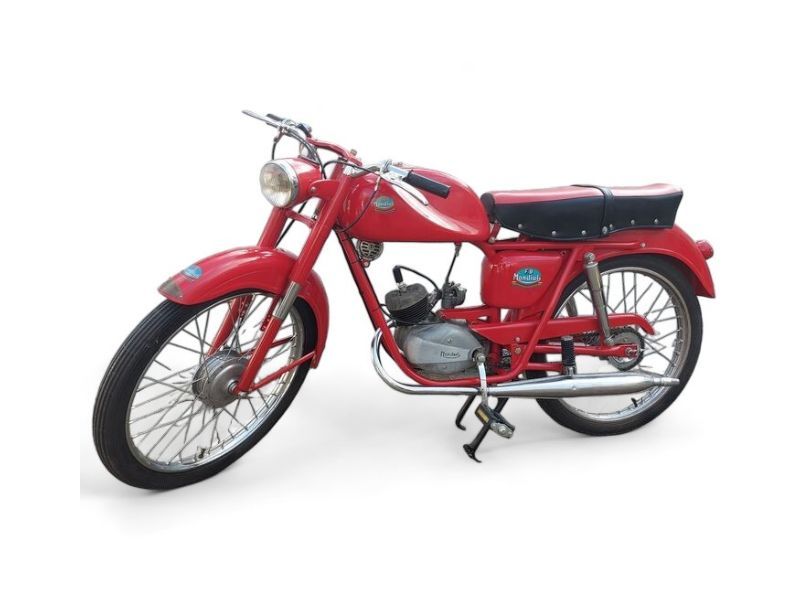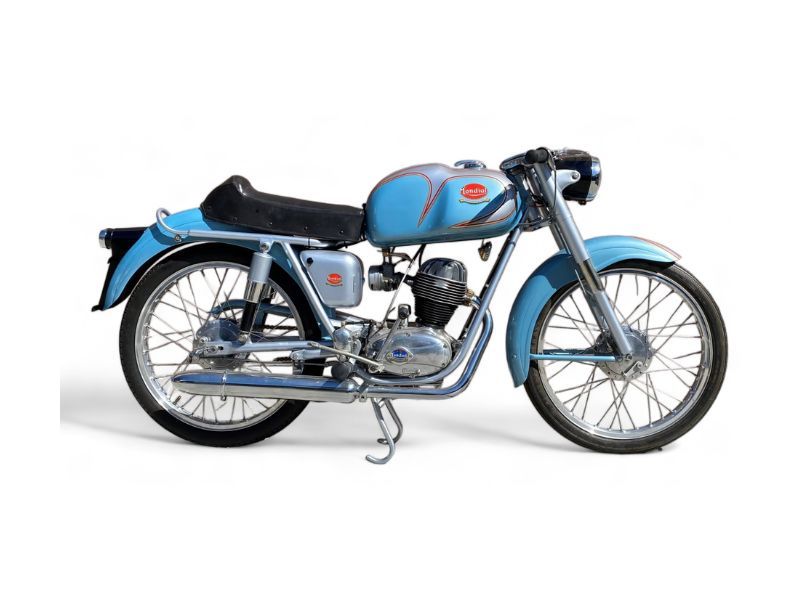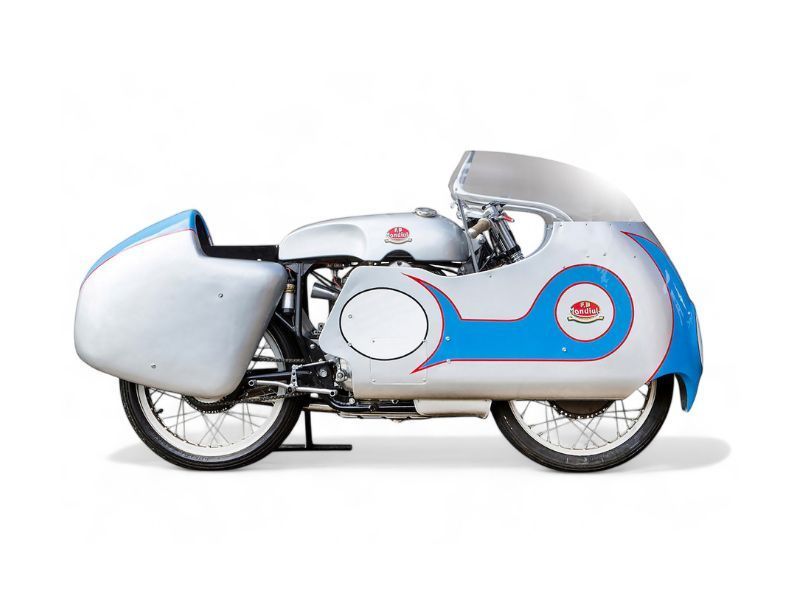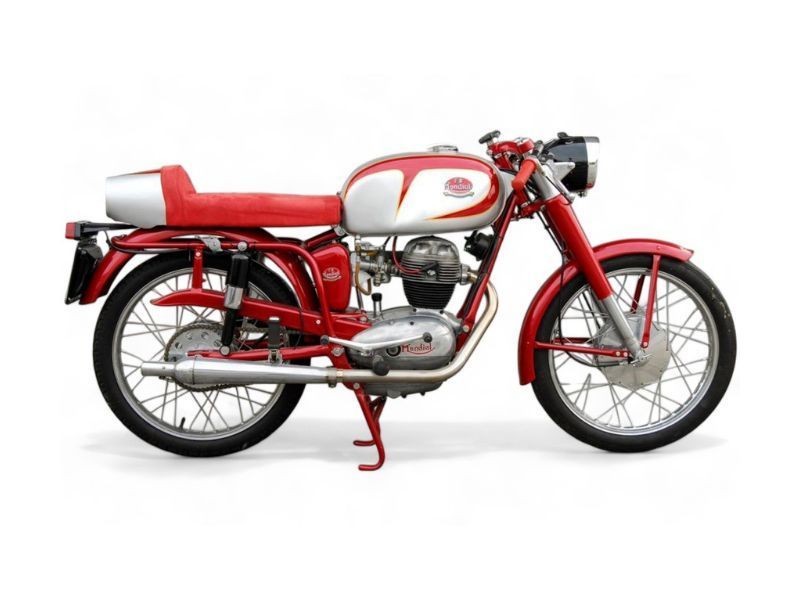History of FB Mondial
The year was 1929, in the heart of Italy, when the Boselli siblings decided to carve a niche for themselves on the racing circuits.
Through the formation of FB Mondial, their love for speed culminated in groundbreaking innovations, racing success, and a loyal fan base.
Now let's get into the rich history of FB Mondial — discovering how it moved from success to disappearing for almost 20 years, and its rebirth.
Origin Story
The legacy of FB Mondial can be traced back to 1929, set to life by the collective vision of former competitive motorcyclist Giuseppe Boselli and his brothers — Luigi, Carlo, Ettore, and Ada.
The initials 'FB' were drawn from their familial roots, dubbed as 'Fratelli Boselli', which translates to 'Boselli Brothers'. The Boselli family or Conti (Counts) Boselli belonged to the landed aristocracy of Piacenza and originally came from Ancarano, Italy.
Fratelli Boselli had initially opened a Milan motorcycle shop — El Negusiet. Here, they sold GD and CM's two-stroke machines. They then bought a building in Bologna — owned by Oreste and Alfonso Drusiani — to manufacture moto furgoncino (three-wheeled utility vehicles) and light trucks for transporting goods.
However, WWII bombings damaged their production site, leading to military commandeering of their machines and a pause in production.
In 1946, due to Boselli's resources, they were able to resume production. In 1948, they started a new business in Milan to cater to the transportation needs that arose after the war — building small-capacity motorbikes called Mondial (Mondial is a French word meaning worldwide).


History
Due to his history as a competitive racer, Giuseppe Boselli understood the importance of racing success in the company's (FB Mondial) recognition. He had actually been awarded a gold medal at the 1935 International Six Days Trial (ISDT) in Oberstdorf, Germany. And the motorcycle he rode to victory was fitted with an FB 4-stroke CM model engine.
Giuseppe Boselli therefore reached out to chief engineer Alfonso Drusiani to create a good speedster.
The 125cc four-stroke single-cylinder engine with dual overhead camshafts had immediate success in competitive racing. FB Mondial clinched their first of several World Championships within just two years of production.
End of a Racing Legend
Despite their prosperous racing performance, FB Mondial decided to withdraw from the Grand Prix competition in 1957 in response to increasing costs and diminishing sales. However, their popularity and in turn sales were greatly affected as a result.
The following years saw a distinct shift in motor manufacturing. While other companies predominantly produced lightweight two-stroke motorcycles, Mondial maintained its 'boutique' manufacturer label —specializing in high-performance, small-displacement motorcycles often crafted by hand.

Key Milestones
Mondial's Quick Leap to Track Triumphs
Over this period, Mondial turned heads as a leading manufacturer of some of the most advanced and successful Grand Prix road racers of the era.
List of Services
-
1949List Item 1
Just a year after its inception, Mondial claimed its first World Championship in the 125cc category. The legendary Nello Pagani was the rider who achieved this feat.
-
1950List Item 2
The winning streak continued into 1950 with Bruno Ruffo securing the World Championship and Constructors' Championship in the 125cc category. His teammates, Gianni Leoni and Carlo Ubbiali, were runners-up and contributed to the Constructors' success.
-
1951List Item 3
The World Championship and Constructors’ Championship in the 125cc category were won by Carlo Ubbiali with runners-up Gianni Leoni and C McCandless contributing to Mondial's success.
-
1954List Item 4
A change of pace from the 125cc class to the 175cc motorcycle came in 1954 with the introduction of a single-cam bike. Remo Venturi triumphed with this machine in the Milan-Taranto race, outpacing motorcycles up to 500cc.
-
1955
Arquinio Provini showcased Mondial's growing stature in 1955, winning the 250 class of the Shell Gold Cup in Imola. Provini rode a specially modified 175 that had been adapted for increased displacement.
-
1956
The company's proficiency extended into motocross, with Emilio Ostorero capturing an Italian Motocross Championship.
-
1957
Mondial's riders and motorcycles proved formidable yet again, securing both the riders' and constructors' titles in the challenging 125cc and 250cc classes.
Early Innovations and Technological Leadership
Mondial distinguished itself through a commitment to high-performance, small-displacement motorcycles. This was a stark contrast to the economic, lightweight, two-stroke models offered by companies like MV Agusta and Ducati in the mid-20th century.
List of Services
-
1948List Item 1
First 4-stroke Engine Motorcycle in the 125cc Category.
The inception of Mondial's innovation can be traced back to the release of their first motorcycle, equipped with a modern twin-cam engine — this was the launch of the first 4-stroke engine in the 125cc category.
-
1949List Item 2
Responding to high demand, Mondial released a 125 model available to the public in four versions: Touring, Sport, and Supersport, with a Corsa model specifically designated for private racers.
-
1951List Item 3
Expansion of the product lineup saw the introduction of the 200 4t and 160 2t models, demonstrating Mondial's versatility and engineering prowess.
-
1953List Item 4
The manufacturing of the Sogno model began, leveraging the engine from the 160 model and marking a new chapter in motorcycle innovation.
-
1954
Introduction of the innovative 175 single-cam and the launch of the 49cc Mondialino, featuring a 2-speed transmission.
-
1955
Production commenced on the 175 TV single-cam chain-driven model, a brainchild of engineer Prampolini.
-
1956
Mondial’s Best-Selling Motorcycle
The 125 Champion model graced the production line, becoming one of Mondial's best-selling motorcycles through its use of pushrods and rockers.
FB Mondial's focus on higher-revving four-strokes — evident in their 125cc and 250cc race engines capable of revving to more than 11,000 rpm — set a standard for performance and engineering excellence during this period.
-
1957
Setting New Standards with Desmodromic Engine and Disc Brakes
FB Mondial was a pioneer in motorcycle engineering, being the first to design a prototype engine with desmodromic valve gear — influenced by the Mercedes-Benz desmo engines that won that year's Formula 1 race. It also introduced the use of disc brakes on motorcycle engines.
2015: Rebirth and Continued Innovation
Marking its return, F.B. Mondial presented the HPS 125 at the EICMA show, reintroducing the brand to the modern motorcycle market.
List of Services
-
2016List Item 1
Following the success of the Hipster 125 cc, the introduction of the HPS 300 cc demonstrated Mondial's response to market demand for larger displacement versions.
-
2017List Item 2
The SMX 125 cc launch showed Mondial's adaptability and reaction to evolving market trends.
-
2018List Item 3
Keeping at the forefront of design innovation, the unveiling of the Sport Classic Pagani in 125 cc and 300 cc displacements showed Mondial's commitment to blending classic aesthetics with modern performance.
-
2019List Item 4
The expansion into new territories with the launch of an authentic Flat Track motorcycle showcased Mondial's dynamism and versatility.
-
2020
Reinventing itself, Mondial entered the scooter market with the introduction of the Imola.
-
2021
The launch of the Piega naked bike highlighted the unique Italian design, continuing Mondial's tradition of elegance and innovation.
-
2022
The Spartan is launched, targeting new generations of motorcyclists and aiming to appeal to a diverse rider base, especially the female audience.
-
EICMA 2023
With the unveiling of two new models, PIEGA 452 and FLEX, in the 300 cc and 500 cc categories, Mondial demonstrated its growth and ongoing commitment to innovation and design excellence.

Legacy and Impact
Influencing the Giants: A testament to Mondial's impact on the industry was the gesture by Soichiro Honda, the founder of Honda Motor Company. After Mondial's remarkable achievements in the 1957 Grand Prix season, Honda acquired a Mondial race bike, which then served as a benchmark for Honda's future motorcycles.
A Source of Inspiration: The Mondial 125 cc race bike, a symbol of the brand's racing success and technological excellence, proudly sits as the first exhibit at Honda's Motegi Collection Hall. This positioning not only honors Mondial's historic significance but also serves as a bridge connecting the past with the present, inspiring future generations of engineers and designers.
Noteworthy Statistics
Here are some key statistics that mark FB Mondial's journey and achievements:
- FB Mondial distinguished itself by manufacturing its motorcycles largely by hand. This dedication to craftsmanship ensured that production volumes remained limited, with yearly outputs ranging between 1,000 and 2,000 units. It also established Mondial's boutique status in the motorcycle industry and made the motorcycles more appealing to bike lovers.
- During FB Mondial's golden years of racing (1949-1957), it clinched an impressive tally of 10 World Championships. This included five rider championships and five manufacturer championships. This achievement highlighted the brand's engineering expertise and competitive spirit.
Models by Type
From the adrenaline-pumping Piega 452 designed for A2 license holders — to the compact, city-slick Imola 50 — every FB Mondial model promises style, performance, and comfort on every level.
List of Services
-
Piega 452List Item 1
The FB Mondial Piega 452 is for A2 license riders with its 449.5cc engine, delivering 35 kW of power for an engaging ride.
It's lightweight at 176 kg for easy handling and combines a 6-speed gearbox, Brembo brakes, and 10-liter fuel capacity for both commuting and outings.
An 820 mm seat height and a TFT display for smartphone connectivity add to its rider-friendly features, making it a versatile choice for the modern motorcyclist.
-
Piega 124List Item 2
The FB Mondial Piega 125 promises an exciting ride with a 124cc twin-cam engine and Dell’Orto fueling.
This lightweight motorcycle, at merely 133 Kg, incorporates a sporty style for those who value intense, dynamic driving. Its 6-speed transmission, 9.5L fuel tank, and seat height at 820 mm also add to its performance credentials.
A unique aspect of the Piega 125 is the fully customizable TFT display for an optimized riding experience.
-
FLEX 300List Item 3
The FB Mondial FLEX 300 merges everyday utility with the thrill of city riding.
Its design focuses on the comfort of both rider and passenger and features a 292 cc engine for robust power and torque.
With a 6-speed gearbox, extensive 17L fuel capacity, and agile handling, the FLEX 300 transforms urban travel into a dynamic adventure and personalized experience.
-
HPS 125
The HPS 2024 125 combines timeless elegance with modern performance. It's light on its feet at 133 kg with a seat height of 790 mm, for an accessible, intuitive ride.
In addition, its sleek 124 cc, DOHC engine outputs 10.5 kW and 10.5 Nm of torque for lively rides.
The 9.5 L fuel tank and 6-speed gearbox sync for city sprints or open road adventures, while the 100/90-18" and 130/80-17" tires ensure reliable traction.
-
SPARTAN 250
At a comfortable seat height of 800 mm and weighing 128 kg, the Spartan 250 promises a smooth ride for any motorcycle lover.
Under the retro exterior lies a 223 cc engine with 10.5 kW of power and 10.5 Nm of torque, paired with a 6-speed gearbox.
Its 15 L fuel tank is ready for long journeys, while the color display and LED headlights highlight the fusion of eras.
-
SPARTAN 125
The Spartan 125 represents classic two-wheel designs, yet stands out with its low seat at 800 mm — making it a perfect fit for every rider.
This 125 cc bike packs 10.5 kW of power with a torque of 10.5 Nm, for amazing rides.
A modern color display and brilliant LED lights pair with a generous 15 L fuel tank and 5-speed transmission, all wrapped up in a design that turns heads and excites the soul.
-
SMX MOTARD
The SMX 125 Motard is equipped with a large-diameter front brake and dual-channel ABS, promising unparalleled safety without compromising on excitement.
Its 124 cc twin-cylinder engine with a Dell’Orto fuel system, delivers 10.5 kW of power and 10.5 Nm of torque, so every ride pulsates with energy.
At 124 kg and with a seat height of 940 mm, this is truly for lovers of sporty riding and true motard fans.
-
SMX ENDURO
The Enduro Euro 5 from the SMX 125 series is designed for any terrain. Its long-travel suspensions and 21/18″ wheels coupled with off-road tires guarantee comfort and control beyond the paved roads.
Power comes easy with a twin-cam 125 cc engine, delivering 10.5 kW of power and 10.5 Nm of torque. And at 125 kg with a seat height of 980 mm, it promises every rider the confidence to conquer the untamed.
-
FLAT TRACK
The Flat Track by F.B. Mondial incorporates 19″ wheels and Flat Track tires to let riders maneuver with ease. It's also equipped with a 125cc twin-cam engine and a Dell’Orto fuel system for sheer performance.
Weighing 140 kg with a seat height of 846 mm, it promises a responsive riding experience for every rider.
-
IMOLA 125
The Imola 125 captures the sporting essence in a compact, urban package.
Its sleek design turns heads, but it's the keyless ignition system that truly ignites the joy of riding. Pair that with the bike's efficient 125cc 4-stroke engine — which balances performance with economy — and you have a ride that's as thrilling as it is smart.
It's light at 121 kg with a low seat height of 770 mm, making every urban journey comfortable and convenient.
-
IMOLA 50
With an eye-catching design and its 50cc engine, the Imola 50 delivers efficiency with reduced fuel consumption.
It's lightweight at 110 kg, with a seat height of 770 mm, so it can weave through streets effortlessly. And with its keyless system, riders enjoy the simplicity and modern touch, ensuring swift departures and smooth journeys every time.

